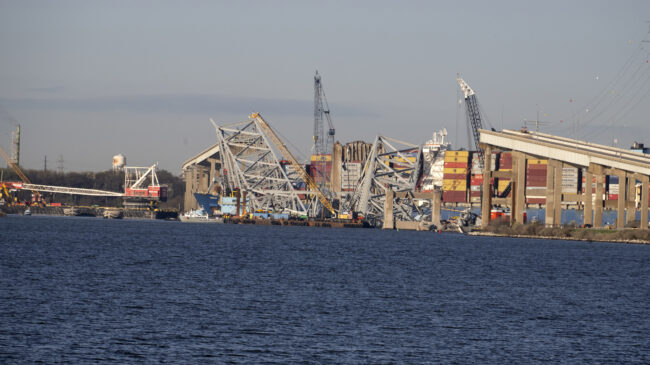The collapse of Maryland’s Francis Scott Key Bridge has renewed scrutiny of bridge safety and agency decision-making. While bridge pier protectors might have prevented the bridge tragedy in Baltimore that killed six people, it’s crucial to thoroughly analyze safety benefits, construction costs, risks, and trade-offs before concluding that their absence in Baltimore was a mistake or if other bridges now need them.
The Key Bridge opened in 1977. It was the final section of the I-695/SR 695—Baltimore’s Beltway. The bridge’s main span was the third-largest span of any truss bridge in the world. With the bridge, I-695 provided a 51-mile loop around a region that rivaled Philadelphia and Washington, D.C., in population and economic output. Business Insider reported the goods flowing through the Port of Baltimore contributed “$15 million in daily economic activity,” which has come to a “near-standstill” due to the bridge collapse.
The Key Bridge, and most other bridges built then, lacked concrete structures commonly referred to as “dolphins,” which act as bumpers to prevent boats from hitting critical bridge support structures. In 1977, engineers did not have the research available today to show the dangers of a collision. Also, in 1977, cargo ships were half the size of today’s ships, and a strike to a support pillar was less dangerous.
After the Sunshine Skyway Bridge (I-275) in the Tampa Bay area was hit by a freighter and collapsed in 1980, new protection measures like dolphins became standard practice for new bridges. The American Association of State Highway and Transportation Officials (AASHTO) published lessons from the Florida bridge collapse in 1991, and the subsequent guidelines provided recommendations for new bridges and standards for retrofitting older bridges. However, the guidelines were suggestions and not binding.
While dolphins are highly effective, they are not cheap. Over time, the replacement Sunshine Skyway Bridge included adding 36 dolphins for $36 million, or $94 million in 2024 dollars. Yet when the bridge reopened in 1987, only four of the dolphins had been constructed. Over the subsequent years, as costs allowed, the remaining dolphins were built.
Bridges routinely cost hundreds of millions of dollars, so adding safety features to new bridges that add $100 million may be reasonable. However, deciding when to retrofit an existing bridge is much more complicated.
On one hand, the Key Bridge is on a major trade route. Ships destined for the Port of Baltimore must sail under it. With the deepening of the Panama Canal and the Baltimore Harbor, bigger ships are now traversing the Patapsco River. While sea captains are skilled operators, unexpected incidents, such as a Dali’s loss of propulsion possibly due to contaminated fuel, which is the leading theory on the Key Bridge crash, may still occur.
On the other hand, in the first 47 years of the bridge, there weren’t any major incidents. Some container ships are towed into port by tugboats, lessening any chance of a bridge strike. Early reports suggest this was a freak accident. If it turns out that contaminated fuel was the main cause of this accident, ensuring fuel quality may be a wiser focus for policymakers, both because it may have been a primary cause of the accident and because it could be a more cost-effective solution.
Even if policymakers decide we must retrofit bridges, which do we choose? Each dolphin costs about $3 million, adding up to $100 million or more per bridge. The $1.2 trillion Infrastructure Investment and Jobs Act (IIJA) provides $2.5 billion per year in bridge funding. States can use other programs, such as the Congestion Mitigation and Air Quality (CMAQ) program for bridges.
However, bridges are not cheap, so states must decide how to best spend their bridge money. If a state transportation department needs to decide between retrofitting a structurally deficient bridge or adding dolphins to a bridge with a low average annual daily traffic volume, most will choose the former.
Clearly, retrofitting bridges on small rivers with little navigable traffic does not make sense. The best candidates are bridges that traverse major rivers used by the biggest ships in the Western Hemisphere.
But how many bridges is that? While the ports of Los Angeles-Long Beach, New York-New Jersey, Savannah, and Norfolk would all qualify, all of the bridges on the rivers leading to these ports already have dolphins. Elsewhere, The New York Times reports:
A New York Times analysis of federal data and shipping traffic found dozens of these vulnerable bridges spanning waterways that serve as corridors for large vessels — around places like Boston, New Orleans and Philadelphia.
The Time’s findings warrant investigation by the states and agencies involved in operating and maintaining those bridges. In terms of the nation’s shipping and vehicle traffic, that’s not a lot of bridges. It’s likely the U.S. has relatively few bridges near major ports that need to be retrofitted with dolphins.
Going forward, policymakers should determine the realistic risks of another large cargo ship hitting a major bridge without dolphins, whether dolphins or other safety measures would be wise investments for those bridges and public safety, and what cost-effective modernization efforts could help prevent accidents like the Key Bridge collapse.

